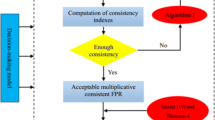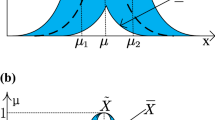Abstract
This paper aims to develop a novel decision-making method with interval type-2 trapezoidal fuzzy preference (IT2TrFPR), which can deal with the complex decision information presented in the form of interval type-2 trapezoidal fuzzy numbers. In this paper, we mainly propose a novel interval type-2 trapezoidal fuzzy decision-making method with local consistency adjustment strategy and data envelopment analysis (DEA). Considering the harm of fog-haze pollution to the environment and human life, we apply the decision-making method to the problem about influence factors of for-haze weather. Firstly, we introduce the definition of IT2TrFPR that sufficiently expresses the uncertainty of original decision-making information. After that, we show the definition of the order consistency and additive consistency for IT2TrFPR. Considering that the original IT2TrFPR given by decision-makers usually does not satisfy the characteristic of consistency, to transform the unacceptable additive consistent IT2TrFPRs into acceptable ones, we design a consistency-improving algorithm that uses the local adjustment approach to preserve the original decision-making information as much as possible and avoids the original information loss. Then, an output-oriented interval type-2 trapezoidal fuzzy DEA model and the concept for quasi interval type-2 trapezoidal fuzzy priority weight are developed to derive the interval type-2 trapezoidal fuzzy priority weight vector (IT2TrFPW) and obtain the final ranking result of alternatives. Finally, the effectiveness of the proposed decision-making method is demonstrated by a numerical example of selecting the most crucial fog-haze influence factor. Meanwhile, we also conduct a comparative analysis by comparing our method with the existing methods to show some merits of the proposed method.


Similar content being viewed by others
References
Li C, Zhu Z (2018) Research and application of a novel hybrid air quality early-warning system: a case study in China. Sci Total Environ 626:1421–1438
Zhao D, Xin J, Gong C, Quan J, Liu G, Zhao W, Wang Y, Liu Z, Song T (2019) The formation mechanism of air pollution episodes in Beijing city: insights into the measured feedback between aerosol radiative forcing and the atmospheric boundary layer stability. Sci Total Environ 692:371–381
Chen Z, Cui L, Cui X, Li X, Yu K, Yue K, Dai Z, Zhou J, Jia G, Zhang J (2019) The association between high ambient air pollution exposure and respiratory health of young children: a cross sectional study in Jinan. China Sci Total Environ 656:740–749
Jin FF, Ni ZW, Pei LD et al (2019) A decision support model for group decision making with intuitionistic fuzzy linguistic preferences relations. Neural Comput Appl 31(S2):S1103–S1124
Liu C, Tang GL, Liu PD et al (2019) Hesitant fuzzy linguistic Archimedean aggregation operators in decision making with the Dempster–Shafer belief structure. Int J Fuzzy Syst 21:1330–1348
Tanino T (1984) Fuzzy preference orderings in group decision making. Fuzzy Sets Syst 12(2):117–131
Wu Z, Xu J (2012) A concise consensus support model for group decision making with reciprocal preference relations based on deviation measures. Fuzzy Sets Syst 206:58–73
Saaty TL (1980) The analytic hierarchy process. McGraw-Hill
Herrera F, Herrera-Viedma E, Chiclana F (2001) Multiperson decision-making based on multiplicative preference relations. Eur J Oper Res 129(2):372–385
Orlovsky SA (1978) Decision-making with a fuzzy preference relation. Fuzzy Sets Syst 1(3):155–167
Lee HS (2005) On fuzzy preference relation in group decision making. Int J Comput Math 82(2):133–140
Nurmi H (1981) Approaches to collective decision making with fuzzy preference relations. Fuzzy Sets Syst 6(3):249–259
Deng XY, Jiang W (2019) Evaluating green supply chain management practices under fuzzy environment: a novel method based on D number theory. Int J Fuzzy Syst 21:1389–1402
Li CC, Dong Y, Xu Y, Chiclana F, Herrera-Viedma E, Herrera F (2019) An overview on managing additive consistency of reciprocal preference relations for consistency-driven decision making and fusion: taxonomy and future directions. Inform Fusion 52:143–156
Cao D, Leung LC, Law JS (2008) Modifying inconsistent comparison matrix in analytic hierarchy process: A heuristic approach. Dec Support Syst 44(4):944–953
Zeshui X, Cuiping W (1999) A consistency improving method in the analytic hierarchy process. Eur J Oper Resh 116(2):443–449
Herrera-Viedma E, Herrera F, Chiclana F, Luque M (2004) Some issues on consistency of fuzzy preference relations. Eur J Oper Res 154(1):98–109
Dong Y, Xu Y, Li H (2008) On consistency measures of linguistic preference relations. Eur J Oper Res 189(2):430–444
Liu F, Zhang WG, Zhang LH (2014) Consistency analysis of triangular fuzzy reciprocal preference relations. Eur J Operat Res 235(3):718–726
Wang ZJ, Tong X (2016) Consistency analysis and group decision making based on triangular fuzzy additive reciprocal preference relations. Inf Sci 361:29–47
Herrera-Viedma E, Chiclana F, Herrera F et al (2007) Group decision-making model with incomplete fuzzy preference relations based on additive consistency. IEEE Trans Syst, Man, Cybernetics, Part B (Cybernetics) 37(1):176–189
Lee LW (2012) Group decision making with incomplete fuzzy preference relations based on the additive consistency and the order consistency. Exp Syst Appl 39(14):11666–11676
Chen SM, Lin TE, Lee LW (2014) Group decision making using incomplete fuzzy preference relations based on the additive consistency and the order consistency. Inf Sci 259:1–15
Liu J, Xu Q, Chen H, Zhou L, Zhu J, Tao Z (2019) Group decision making with interval fuzzy preference relations based on DEA and stochastic simulation. Neural Comput Applic 31(7):3095–3106
Ma J, Fan ZP, Jiang YP et al (2006) A method for repairing the inconsistency of fuzzy preference relations. Fuzzy Sets Syst 157(1):20–33
Zhang H (2019) Revisiting multiplicative consistency of interval fuzzy preference relation. Comput Ind Eng 132:325–332
Deli I, Eraslan S (2018) Çağman N ivnpiv-Neutrosophic soft sets and their decision making based on similarity measure. Neural Comput Appl 29:187–203
Mahdevari S, Shahriar K, Esfahanipour A (2014) Human health and safety risks management in underground coal mines using fuzzy TOPSIS. Sci Total Environ 488:85–99
Chen L, Xu Z (2015) A new fuzzy programming method to derive the priority vector from an interval reciprocal comparison matrix. Inf Sci 316:148–162
Jin FF, Pei LD, Liu JP et al (2019) Decision-making model with fuzzy preference relations based on consistency local adjustment strategy and DEA. Neural Comput Applic 32:11607–11620. https://doi.org/10.1007/s00521-019-04648-1
Wang YM, Chin KS A new data envelopment analysis method for priority determination and group decision making in the analytic hierarchy process. Eur J Oper Res 195, 2009(1):239–250
Wu DD (2009) Performance evaluation: an integrated method using data envelopment analysis and fuzzy preference relations. Eur J Oper Res 194(1):227–235
Barak S, Dahooei JH (2018) A novel hybrid fuzzy DEA-fuzzy MADM method for airlines safety evaluation. J Air Transp Manag 73:134–149
Han Z, Liu P (2011) A fuzzy multi-attribute decision-making method under risk with unknown attribute weights. Technol Econ Dev Econ 17(2):246–258
Mousakhani S, Nazari-Shirkouhi S, Bozorgi-Amiri A (2017) A novel interval type-2 fuzzy evaluation model based group decision analysis for green supplier selection problems: a case study of battery industry. J Clean Prod 168:205–218
Qin J, Liu X (2015) Multi-attribute group decision making using combined ranking value under interval type-2 fuzzy environment. Inf Sci 297:293–315
Meng F, Li S (2020) A new multiple attribute decision making method for selecting design schemes in sponge city construction with trapezoidal interval type-2 fuzzy information. Appl Intel 9
Abdullah L, Najib L (2014) A new type-2 fuzzy set of linguistic variables for the fuzzy analytic hierarchy process. Expert Syst Appl 41(7):3297–3305
Wang W, Liu X, Qin Y (2012) Multi-attribute group decision making models under interval type-2 fuzzy environment. Knowl-Based Syst 30:121–128
Xu Y, Patnayakuni R, Wang H (2013) The ordinal consistency of a fuzzy preference relation. Inf Sci 224:152–164
Xu Z, Chen J (2008) Some models for deriving the priority weights from interval fuzzy preference relations. Eur J Oper Res 184(1):266–280
Zadeh LA (1975) The concept of a linguistic variable and its application to approximate reasoning—I. Inform Sci 8(3):199–249
Mendel JM (2007) Type-2 fuzzy sets and systems: an overview. IEEE Comp Intel Mag 2(1):20–29
Mendel JM, John RI, Liu F (2006) Interval type-2 fuzzy logic systems made simple. IEEE Trans Fuzzy Syst 14(6):808–821
Chen TY (2013) A linear assignment method for multiple-criteria decision analysis with interval type-2 fuzzy sets. Appl Soft Comput 13(5):2735–2748
Ngan SC (2013) A type-2 linguistic set theory and its application to multi-criteria decision making. Comput Indust Eng 64(2):721–730
Zhang Z, Zhang S (2013) A novel approach to multi attribute group decision making based on trapezoidal interval type-2 fuzzy soft sets. Appl Math Model 37(7):4948–4971
Zhang Z, Guo C (2014) Consistency-based algorithms to estimate missing elements for uncertain 2-tuple linguistic preference relations. Int J Comput Intel Syst 7(5):924–936
Liu JP, Chen PP, Chen HY et al (2018) The ranking method of interval linguistic preference relations based on cross efficiency DEA and stochastic simulation. Syst Eng-Theory Pract 38(4):950–959
Ma X, Wu P, Zhou L, Chen H, Zheng T, Ge J (2016) Approaches based on interval type-2 fuzzy aggregation operators for multiple attribute group decision making. Int J Fuzzy Syst 18(4):697–715
Chen S M, Lee L W. Fuzzy multiple criteria hierarchical group decision-making based on interval type-2 fuzzy sets. IEEE Trans Syst, Man, Cybernetics-Part A: Syst Humans, 40(5) (2010) 1120–1128
Yao LM (2020) Incomplete interval type-2 fuzzy preference relations based on a multi-criteria group decision-making model for the evaluation of wastewater treatment technologies. et al., Measurement (151):107137
Jin F, Ni Z, Chen H, Li Y (2016) Approaches to decision making with linguistic preference relations based on additive consistency. Appl Soft Comput 49:71–80
Gou X, Liao H, Xu Z, Min R, Herrera F (2019) Group decision making with double hierarchy hesitant fuzzy linguistic preference relations: consistency based measures, index and repairing algorithms and decision model. Inf Sci 489:93–112
Acknowledgments
This study was funded by National Natural Science Foundation of China (Nos. 71901001, 72071001, 71871001), the Humanities and Social Sciences Planning Project of the Ministry of Education (No. 20YJAZH066), Natural Science Foundation of Anhui Province (Nos. 2008085QG333, 2008085MG226), Key Research Project of Humanities and Social Sciences in Colleges and Universities of Anhui Province (Nos. SK2019A0013, SK2020A0038), Project of Anhui Ecological and Economic Development Research Center (No. AHST2019009).
Author information
Authors and Affiliations
Corresponding author
Ethics declarations
Conflict of interest
The authors declare no conflict of interest.
Additional information
Publisher’s note
Springer Nature remains neutral with regard to jurisdictional claims in published maps and institutional affiliations.
Rights and permissions
About this article
Cite this article
Liu, J., Zheng, Y., Jin, F. et al. Local consistency adjustment strategy and DEA – driven interval type-2 trapezoidal fuzzy decision-making model and its application for fog-haze factor assessment problem. Appl Intell 52, 1653–1671 (2022). https://doi.org/10.1007/s10489-021-02354-x
Accepted:
Published:
Issue Date:
DOI: https://doi.org/10.1007/s10489-021-02354-x




